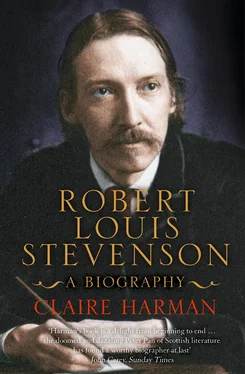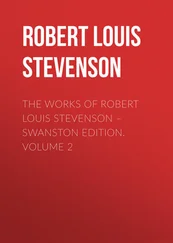Stevenson was also heading for rhetorical meltdown with Mrs Sitwell. In the years he was in thrall to her, he gave her many different names, clearly a symptom of confusion about their relationship. First there was ‘Claire’, then ‘Madame’, ‘Madonna’, ‘Maud’ (from Tennyson’s poem, not Mrs Babington), and ‘Mother’; there was even a brief spell of ‘Lady Superintendent’ when Mrs Sitwell first took up that post at the College for Working Women. In Menton, Stevenson started to call her ‘Consuelo’, after the heroine of George Sand’s Mademoiselle Merquem : ‘Consuelo. Consolation of my spirit. Consolation.’ 55 In the book, Consuelo escapes an unhappy marriage and is free to marry the young man she really loves, but in real life the plot threatened to work out rather differently, and Stevenson was hard-pressed to know how to re-imagine his relationship with his newly-independent beloved. His confusion was obvious when he signed one letter, at Christmas 1874, ‘ever your faithful friend and son and priest’, having spoken of her as his ‘deity’, whose shrine he would tend forever. Wild though this is, Mrs Sitwell must have liked it, for she marked the letter ‘Keep this very safe for me.’ 56
Once Stevenson began to develop the mother – son metaphor in his letters to Mrs Sitwell, the results were astonishing:
And so, my beautiful and good and O surely not quite unhappy , mother of election, so you must be brave for my sake, and let me think of you with happiness and not with pain. Day by day, you become more to me; and day by day, I must acknowledge to myself how dependent I am on you for all that is good and beautiful in my poor life. This is the consolation I have given you always; and I now know no other: think of how I cling to you, Madonna, my mother; think of how you must be to me throughout life the mother’s breasts to suckle me, and be brave, dear, and be for me a brave mother; if I am to be a son, you must be a mother; and surely I am a son in more than ordinary sense, begotten of the sweet soul and beautiful body of you, and taught all that ever I knew pure or holy or of good report, by the contact of your sweet soul and lovely body [ … ] I long to be with you most ardently, and I long to put my arms about your neck and kiss you, and then sit down with my head on your knees, and have a long talk, and feel you smoothing my hair. 57
He seems desperate in these months to reach an unchangeable state with his tormentingly lovely and devoted friend, writing to her of the ‘perpetual treasure’ of her heart and his belief that ‘you will never change to me any more; I believe it is safe’. 58 ‘Surely between you and me, all that there is, is restful – is it not?’ he asked nervously in January 1875, half-hoping for the answer No. Electing her as ‘Mother’ might have been expected to help free the relationship from the vicissitudes of sexual longing, except that Stevenson was the first to admit that ‘it is not a bit like what I feel for my mother here ’. 59 He got much nearer to articulating his ideal when he rhapsodised to her about a photograph of the Parthenon pediment sculpture known as the Three Fates, in front of which he had shed tears with her on his last visit to London. The statue evoked for him ‘a great mythical woman, living alone among inaccessible mountain tops or in some lost Island in the pagan seas; [ … ] think dear, if one could love a woman like that once, see her once grow pale with passion, and once wring your lips out upon hers, would it not be a small thing to die?’ 60 It is an oddly aggressive fantasy, and, directed at a woman he once hoped to possess, tinged with vindictiveness.
Sadly, there was no great mythical woman around to turn Stevenson’s attention away from Frances Sitwell, love for whom was turning into festering misery. ‘You are all the women in the world to me,’ he told her in February, while admitting to Bob, ‘I have dropped out of my service to the second rates.’ 61 He still haunted howffs such as the Gay Japanee, but only to drink or take opium. All that winter he was seedy and in a ‘curiously impressionable state’, rather like the morbid melancholia of his early student days. A crippled girl ‘with that curious voice [ … ] of sexless and ageless deformity’, two lost children being walked to the police station by an officer, the trains curving out of Waverley station seen from high on the North Bridge; all these everyday things affected him queerly, ‘took hold of’ him, as he described it to Mrs Sitwell. ‘I don’t like being so sensitive in town, though,’ he said, ‘the impressions are more often painful than agreeable.’ 62 He was turning into the Caillebotte of Edinburgh – or perhaps its de Nerval. A prose poem that he wrote that year contains this vividly neurasthenic paragraph:
The dresses of harlots swayed and swished upon the pavement. Pale faces leaped out of the crowd as they went by the lights, and passed away like a dream in the general dream of the pallid and populous streets. The coarse brass band filled the air with a rough and ready melody; and the fall of alternate feet, and the turn of shoulders and swish of dresses, fell into time with it strangely. Face after face went by; swinging dress after dress brushed on the even stones; out of face after face the eyes stood forth with a sordid animal invitation. 63
This was the preoccupied, unhappy young man whom Leslie Stephen took with him to Edinburgh Royal Infirmary one day in February 1875. Stephen was in the city to give two lectures on the Alps and had decided to pay a visit not only to ‘Colvin’s friend’, but to another young contributor to the Cornhill who was at that time a long-term patient at the Infirmary. William Ernest Henley, a twenty-six-year-old would-be writer suffering from necrosis of the bone, had arrived in Edinburgh eighteen months earlier. He had already had his left leg amputated below the knee (as a result of tuberculosis), and had been told the second foot was beyond cure, but Henley had heard of the pioneering work of the Edinburgh surgeon Joseph Lister, and came north in 1873 to be treated by him. Lister’s controversial belief was that antiseptics could be used to prevent as well as treat putrefaction, and under his care, with several operations and whole years of bed rest, Henley’s condition was gradually stabilising.
Stephen had been touched by the pathos of Henley’s situation and decided to take Stevenson along with him on his second visit to the gloomy old hospital in the hope that ‘Colvin’s friend’ might be able to lend Henley books and visit him. It was a judicious move: Stevenson was deeply impressed by Henley and wrote enthusiastically to Mrs Sitwell about the ‘bit of a poet’ he had just met:
It was very sad to see him there, in a little room with two beds, and a couple of sick children in the other bed; a girl came in to visit the children and played dominoes on the counterpane with them; the gas flared and crackled, the fire burned in a dull economical way; Stephen and I sat on a couple of chairs and the poor fellow sat up in his bed, with his hair and his beard all tangled, and talked as cheerfully as if he had been in a King’s Palace, or the great King’s Palace of the blue air. He has taught himself two languages since he has been lying there. I shall try to be of use to him. 64
Henley’s intellectual energy, his enormous pleasure in talk and company, were evident from the first, as was his spirited response to his dire predicament and his tormentingly long stay in the hospital. Here was someone whom Louis could help, someone much worse off than himself, seriously ill, and without family or money. But the taint of patronage, which coloured the whole relationship, is also there from the start, with that rather priggish ‘I shall try to be of use to him.’ Stevenson’s second mention of Henley in his letters is to ‘my poet’, to Bob he called him ‘a poor ass in the infirmary’, 65 and only a year later he was describing Henley to a woman he wanted to impress as his ‘pensioner in the hospital’.
Читать дальше












